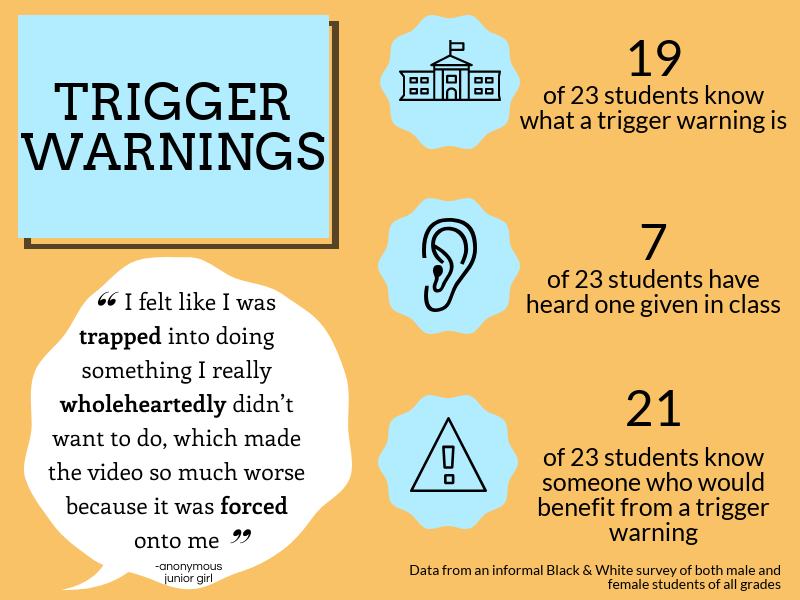MCPS: show more sensitivity, include trigger warnings in teacher training
November 12, 2018
When Whitman and MCPS set out to educate students on mental health last April with the Signs of Suicide video, they did so with the best intentions. But instead of providing comfort or closure, the video forced some students to look back on a time they weren’t ready to remember yet.
“Because the topic hit so close to home, I felt really ambushed by the video,” a junior said. “I was in a room full of people I didn’t know, talking about something I wasn’t ready to talk about, and all of it came without even a warning.”
Not only did some teachers not let their students know what they would be watching, but they forced those who were especially impacted to sit through the video.
Two junior girls tried to leave their classes last year, only to be stopped by their teacher and forced to watch the video, they said.
“I felt like I was trapped into doing something I really wholeheartedly didn’t want to do, which made the video so much worse because it was forced onto me,” one junior said.
When Whitman rolled out another session of Signs of Suicide education Monday, the program was meant to be bolstered by increased staff training, following complaints by students last year. While there were some minor changes, there was still no requirement to run trigger warnings.
“As I watched the senior video, I consistently got more uncomfortable just because there wasn’t that warning,” senior Cassandra Branson said. “I was disappointed at how they did it because it can be a topic that’s very triggering, especially to students at this school.”
The poorly planned first and second run of the program are indicative of a larger problem in the county: widespread insensitivity surrounding potentially triggering topics.
Right now, MCPS doesn’t have a policy on trigger warnings, nor does the Whitman administration include them in staff training. To avoid traumatizing situations for students, MCPS should adopt a policy that streamlines the use of trigger warnings and includes them in teacher training.
A trigger warning is anything that lets someone know when a sensitive topic known to cause negative reactions among students is coming. Trigger warnings in respect to the classroom can be provided on the syllabus, sent out before a lesson or said verbally prior to discussion of a sensitive topic.
The topics of suicide and self-harm, as presented in the video Whitman and the entire county were required to show students, are among the most common triggers for students, National Institute of Mental Health Psychiatrist Erin Berman said. Other common triggers include rape, sexual assault and trauma.
For students who have personal experiences with a topic but lack proper coping strategies, being presented with these subjects can induce a multitude of negative reactions, from a panic attack to a depressive episode. As a way to prepare —and hopefully prevent— students from having any negative reactions, trigger warnings can be used to let students know that these subjects are coming, Psychologist Stephanie Wolf said.
Most students believe that trigger warnings can be helpful, with 21 out of 23 students saying that they know someone who could benefit from a trigger warning, according to an informal Black & White survey.
Everybody is better off if they know what to expect ahead of time, especially regarding sensitive material, Wolf said. Trigger warnings, when used sensibly and not excessively, can potentially help with this.
Instead of being presented as a second thought, effective trigger warnings should be implemented discreetly or in advance, whether that be letting students know sensitive content is coming the day before or offering another assignment. This gives students the time to mentally prepare themselves, and if need be, opt out of that particular lesson to see a counselor in private or work on homework in the hall.
English teacher Omari James uses trigger warnings in the form of an online form in his Media and Society class, specifically prior to the unit on video games and mental health. James uses content warnings to give students the opportunity to make the decision about whether or not they want to take part in the discussion of certain topics. It’s not his place as a teacher to navigate how students cope with something they go through; it should be their choice, he said.
Some argue trigger warnings single certain students out, making those students feel judged. To preempt those reactions, trigger warnings should only ever address the whole class, and make alternate options available in a way that students can stay anonymous. This would keep a student’s needs personal and make it their decision.
Another common argument against trigger warnings is that they interfere with developing adequate coping skills. Developing coping skills, either individually or with the help of a professional, is the most important solution to mental health concerns. The data regarding trigger warnings isn’t definite, meaning it is unclear whether they are psychologically effective, Berman said.
Still, while those skills are developing, trigger warnings can be helpful, Berman said. Even if trigger warnings can’t be everywhere, they can certainly be used prior to content that discusses the most common triggers.
At the end of the day, students should feel respected and understood in the classroom. Trigger warnings are a way of showing that understanding, and as a county we should work to implement anything that can foster a more open environment for students.
This story was updated Wednesday, Nov. 14 to include a reaction to this year’s Signs of Suicide presentation, iincluding a quote from a student.







